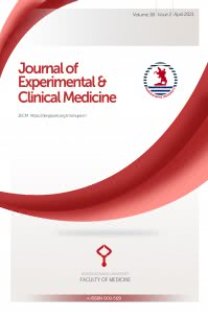Hipoksik ve iskemik ensefalopatilerde nörolojik prognoz. Kardiyak arreste bağlı bir "Persistent Vegetatif Durum" olgusu
Oksijensizlik, Beyin iskemisi, Kalp durması, Seyir
Neurologic prognosis in anoxic and ischemic encephalopathies: A case of the persistent vegetative state after cardiac arrest
Anoxia, Brain Ischemia, Heart Arrest, Prognosis,
___
1. Snyder BD, Tulloch JW. Anoxic and ischcmic encepholopathies. In: Bradley WG, Daroff RB, Fenichel GM, Marsden CD (eds). Neurology in Clinical Practice. (2'nd ed) Volume 2. Boston. Buttcrworth-Heinemann. 1996; 1345-1353.2. Aminoff MJ. Neurological complications of systemic disease: in adults. in: Bradley WG. Daroff RB, Fenichel GM, Marsden CD {eds). Neurology in clıinical practice. (2'nd ed} Volume 2. Boston, Butterworth-Heinemann. 1996; 907.
3. Longstreth WT, Dikmen SS. Outcomes after cardiac arrest. Ann Emcrg Med 1993; 22: 64.
4. Longstreth WT. Neurological complications of cardiac arrest. in: Aminoff MJ (ed). Neurology and general medicine. (2'nd ed). New York, Churchill Livingstone, 1995; 159-182.
5. Snyder BD. Gummit RJ, Leppic IE et al. Neurologic prognosis after cardiopulmonare arrest: IV. Brainstcm reflexes. Neurology 1981; 31: 1092-1097.
6. Young GB. Roppcr AH, Balkım CF. Coma and impaired cosciousness. New York. Mc Graw-Hill,1998.
7. Ashwal S. Crandford RE. Rosenberg JH. Commentary on the practice paremeters for thc persistent vegatative state. Neurology 1995; 45: 859-860.
8. Kumral K, Kumral E. Santral sinir sisteminin damarsal hastalıkları. İzmir. Yücesahil. 1993; 71-85.
9. Tresch DD, Sims FH, Duthie EH, et al. Clinical characterisrics of patients in the persistent vegetative state. Arch Intern Med 1991; 151: 930.
10. Karaman Y. Şuur bozuldukları ve komalar. Kayseri, Erciyes Üniversitesi Basımevi, 1999; 10-11.
11. Shewmon DA, De Giorgio CM. Early prognosis in anoxic coma. Neurol Clin 1989; 74: 823.
12. Levy DE, Caronna JJ. Singer BH et al. Predicting outcome fram hypoxic-ischemic coma. JAMA 1985: 253: 1420-1426.
13. Scolla-Lavizzari G. Bassetti ,C. Prognostic valuc of EEG in poslanoxic coma after cardiac arrest. Eur Neurol 1987; 26: 161-170.
- ISSN: 1300-2996
- Yayın Aralığı: Yılda 4 Sayı
- Başlangıç: 2018
Clinical picture and diagnosis in a patient with optic disc drusen: A case report
Hakkı BİRİNCİ, Murat SAĞLAM, İhsan ÖGE, Altan KAMAN
Yeni bir mesleksel astma nedeni: Rhizoma zingiberis
M. Levent ERKAN, Serhat FINDIK, Hasan TATLISÖZ, Davut UĞURLU, Atilla G. ATICI
Acil serviste yetişkin zehirlenme olgularının geriye dönük analizi
Özgür KARCIOĞLU, Cüneyt AYRIK, Önder TOMRUK, Hakan TOPAÇOĞLU, Ayfer KELEŞ
Dursun AYGÜN, Zahide DOĞANAY, Levent ALTINTOP, Hakan GÜVEN, Mehmet KOŞARGELİR
Yoğun bakım ünitesindeki hastane infeksiyonlarının değerlendirilmesi
SEVGİ CANBAZ, Yıldız PEKŞEN, Hakan LEBLEBİCİOĞLU, A. Tevfik SÜNTER, Şaban ESEN
Hemodiyalize giren kronik böbrek yetmezliği olan hastalarda psikopatoloji
